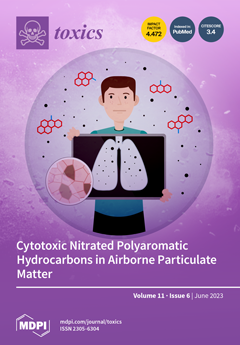Insect glutathione S-transferases (GSTs) serve critical roles in insecticides and other forms of xenobiotic chemical detoxification. The fall armyworm,
Spodoptera frugiperda (J. E. Smith), is a major agricultural pest in several countries, especially Egypt. This is the first study to identify and characterize
[...] Read more.
Insect glutathione S-transferases (GSTs) serve critical roles in insecticides and other forms of xenobiotic chemical detoxification. The fall armyworm,
Spodoptera frugiperda (J. E. Smith), is a major agricultural pest in several countries, especially Egypt. This is the first study to identify and characterize GST genes in
S. frugiperda under insecticidal stress. The present work evaluated the toxicity of emamectin benzoate (EBZ) and chlorantraniliprole (CHP) against the third-instar larvae of
S. frugiperda using the leaf disk method. The LC
50 values of EBZ and CHP were 0.029 and 1.250 mg/L after 24 h of exposure. Moreover, we identified 31 GST genes, including 28 cytosolic and 3 microsomal SfGSTs from a transcriptome analysis and the genome data of
S. frugiperda. Depending on the phylogenetic analysis, sfGSTs were divided into six classes (delta, epsilon, omega, sigma, theta, and microsomal). Furthermore, we investigated the mRNA levels of 28 GST genes using qRT-PCR under EBZ and CHP stress in the third-instar larvae of
S. frugiperda. Interestingly, SfGSTe10 and SfGSTe13 stood out with the highest expression after the EBZ and CHP treatments. Finally, a molecular docking model was constructed between EBZ and CHP using the most upregulated genes (SfGSTe10 and SfGSTe13) and the least upregulated genes (SfGSTs1 and SfGSTe2) of
S. frugiperda larvae. The molecular docking study showed EBZ and CHP have a high binding affinity with SfGSTe10, with docking energy values of −24.41 and −26.72 kcal/mol, respectively, and sfGSTe13, with docking energy values of −26.85 and −26.78 kcal/mol, respectively. Our findings are important for understanding the role of GSTs in
S. frugiperda regarding detoxification processes for EBZ and CHP.
Full article






